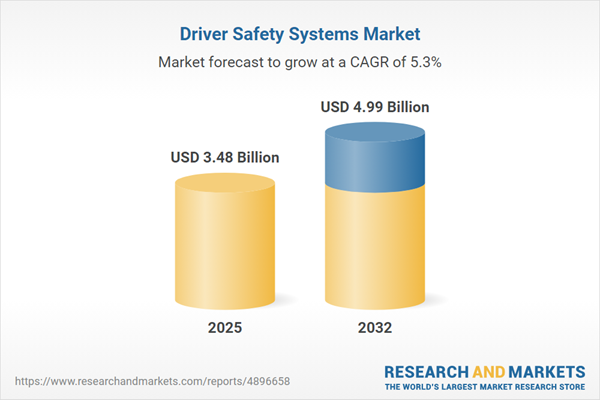Speak directly to the analyst to clarify any post sales queries you may have.
Senior transportation executives face ongoing shifts in the driver safety systems market, as stricter regulations and rapid advancements in digital compliance reshape operational priorities. Strategic investments in integrated safety technologies are crucial for enhancing organizational resilience, optimizing performance, and aligning with swift industry evolution.
Market Snapshot: Latest Trends in the Driver Safety Systems Market
The driver safety systems market is experiencing steady expansion, supported by evolving compliance standards and the swift adoption of advanced digital safety tools. Organizations are introducing connectivity-focused solutions across fleets, using robust data analytics to respond more effectively to changing legal conditions. Key developments highlight the growing role of connected sensors and real-time driver monitoring, which streamline incident response and foster proactive regulatory alignment. Decision-makers now access greater operational transparency and smarter risk-mitigation alternatives, supporting agility as digital transformation accelerates within the sector.
Scope & Segmentation of the Driver Safety Systems Market
- System Types: Adaptive cruise control, blind spot detection, driver monitoring, electronic stability control, automatic emergency braking, and lane departure warning systems deliver proactive driver alerts and raise situational awareness across broad logistics and specialized transport requirements.
- Component Types: Digital signal processors, microprocessors, FPGAs, LiDAR, radar, camera modules, ultrasonic sensors, analytics platforms, and embedded software combine to provide efficient hazard detection, data transfer, and safety-focused decision-making in diverse operational settings.
- Vehicle Types: Solutions are tailored for passenger vehicles as well as light and heavy commercial fleets, supporting distinct compliance and performance demands spanning logistics, executive transportation, and niche vehicle segments.
- Sales Channels: Direct sales, authorized distributors, and original equipment manufacturer partnerships support the integration and upgrade of safety technologies within both new and existing vehicle fleets to match emerging standards.
- Regions Covered: The Americas, Europe, Middle East and Africa, and Asia-Pacific require regionally adapted strategies, acknowledging unique regulatory frameworks and supporting agile technology adoption to match local compliance timelines.
Key Takeaways for Senior Decision-Makers
- Integrating advanced sensors and analytics enables faster incident response and enhances ongoing safety process optimization across all fleet types.
- Maintaining continual compliance depends on regular process updates, elevated data security, and transparent operational reporting, ensuring alignment with regulatory expectations.
- Using biometric tools and enhanced data protocols supports efficient management of complex regulatory environments in multiple international jurisdictions.
- Implementing scalable, modular systems allows organizations to respond rapidly to changing policies, ensuring business continuity and operational flexibility.
- Developing robust alliances with technology vendors and compliance consultants streamlines both the implementation and adaptation of safety technologies to remain in step with evolving standards.
Tariff Impact: Responding to U.S. Trade Shifts in 2025
Recent U.S. tariff adjustments are shaping sourcing strategies for key components such as semiconductors and camera modules within the driver safety systems market. To reduce exposure to volatility, companies are reinforcing domestic supply partnerships and updating procurement models. These actions allow transportation organizations to minimize operational disturbance and continue meeting updated compliance standards on a timely basis.
Methodology & Data Sources
This analysis draws from structured interviews with transportation sector leaders, up-to-date regulatory reviews, and technical insights from automotive engineers. Validation through expert consultation ensures a targeted, actionable perspective for senior executives steering safety initiatives.
Why This Driver Safety Systems Market Report Matters
- Enables informed decisions that streamline procurement, sustain operational consistency, and enhance corporate risk management as regulatory expectations rise.
- Guides technology deployment strategies, supporting platform selection that aligns with current and anticipated compliance goals for efficient fleet management.
- Delivers tailored regional analysis, equipping executive teams to integrate compliance and operational plans as legal contexts change globally.
Conclusion
This report equips senior transportation leaders with critical analysis and actionable recommendations to effectively address regulatory challenges, guide technological adoption, and reinforce operational resilience in the evolving driver safety systems market.
Additional Product Information:
- Purchase of this report includes 1 year online access with quarterly updates.
- This report can be updated on request. Please contact our Customer Experience team using the Ask a Question widget on our website.
Table of Contents
3. Executive Summary
4. Market Overview
7. Cumulative Impact of Artificial Intelligence 2025
Companies Mentioned
The companies profiled in this Driver Safety Systems market report include:- Mobileye Global Inc.
- Robert Bosch GmbH
- Continental AG
- Denso Corporation
- Aptiv PLC
- ZF Friedrichshafen AG
- Magna International Inc.
- Valeo SA
- Autoliv Inc.
- Hella GmbH & Co. KGaA
Table Information
| Report Attribute | Details |
|---|---|
| No. of Pages | 197 |
| Published | October 2025 |
| Forecast Period | 2025 - 2032 |
| Estimated Market Value ( USD | $ 3.48 Billion |
| Forecasted Market Value ( USD | $ 4.99 Billion |
| Compound Annual Growth Rate | 5.2% |
| Regions Covered | Global |
| No. of Companies Mentioned | 11 |









